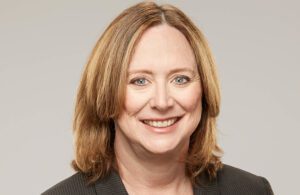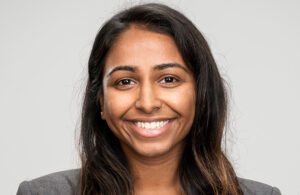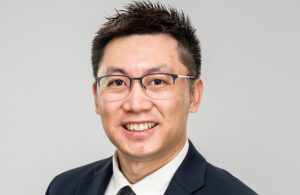
Kathleen Daley is a partner at Finnegan, Henderson, Farabow, Garrett & Dunner. [Photo courtesy of Finnegan]
There’s “significantly more” to it than a good idea for an SaMD algorithm.
Kathleen Daley, Angeline Premraj and Jason Zhang, Finnegan
Technology continues to change the practice of healthcare, and one area where this has become evident is the increasing prevalence of software aimed at healthcare applications. This can include software that is integral to a medical device, software used in the manufacture or maintenance of a medical device, or software that is itself the medical device, also known as Software as a Medical Device (SaMD).
SaMD is an area of tremendous growth in the medical healthcare field. However, there is still significant unpredictability in the patent eligibility of SaMDs. This article provides an overview of the challenges facing the patent eligibility of SaMDs and examines potential strategies to achieve eligibility.
The defining feature of an SaMD lies in its unique role as software that performs independent medical functions without the need for actual medical device hardware. As such, SaMD inventions are often characterized as an “abstract idea” by the U.S. Patent and Trademark Office and face patent eligibility challenges.
SaMDs and the Alice test
In U.S. patent law, patent eligibility is governed by 35 U.S.C. § 101, which defines the types of inventions and discoveries eligible for patentability as “any new and useful process, machine, manufacture, or composition of matter, or any new and useful improvement thereof.” This eligibility requirement is interpreted under the test set forth in 2014 by the U.S. Supreme Court in Alice Corp. v. CLS Bank International.
Under the Alice test, the first inquiry is whether the claims are directed to an abstract idea. Since this is often the case with software algorithms, the relevant inquiry is whether the claims recite additional elements that amount to “significantly more” than an abstract idea, law of nature, or natural phenomena, three long-held exclusions to patent eligibility. If a claim passes this test, the claim is eligible for a patent.
When it comes to SaMD, the innovation lies in its independent function as a medical device, disconnected from any medical device hardware or a physical device. Examples include software that develops a patient treatment plan based on patient input data or image processing software for medical diagnoses.
Thus, the biggest hurdle for these inventions is often that claims reciting a software algorithm are frequently characterized as encompassing an abstract idea. But a potential solution to this hurdle may lie in determining what can constitute “significantly more” than an abstract idea under the Alice test. Specifically, even if a claim is directed to an abstract idea, it can still be patent-eligible where the claim contains an inventive concept — that is, where the claim is based on more than “well-understood, routine, conventional activities.” One way to achieve this “significantly more” characterization is to demonstrate that the invention is directed to an improvement over the current state-of-the-art.
How SaMDs can pass the test
So what does it take for SaMDs to be “significantly more” from a patent perspective? Courts have found claims to be significantly more than an abstract idea when they include improvements to the functioning of a computer. Claims that improve another technology or technical field have also been found to be “significantly more.”
Most relevant to SaMDs, courts have also found that meaningful limitations — more than merely linking the use of the software to a particular technological environment — elevate the claims to significantly more than the abstract idea. In one example, while the claims were directed to collecting and comparing data (similar to SaMDs) for optimizing immunization, the additional step of actually immunizing the patient based on the comparison was a specific application and practical use of the comparison. Thus, tying the data analysis to immunization by reciting an actual step of performing the immunization benefited the claims.
By considering these and other examples, patent owners can streamline drafting patents and patent claims to overcome the hurdles that often stand in the way of patent eligibility for SaMDs in various ways.
First, patent owners may focus on reciting the specific features of the invention that provide technological improvements or solutions. For example, it may be useful to recite diagnostic features that make the data from the measurement device more accurate. If a particular software implementation makes a diagnostic or therapeutic method faster or more efficient, that should be recited in the claim with support in the specification describing how that particular software makes the computer faster or more efficient.
Second, it may be beneficial to avoid excessive reliance on terminology that reads on mathematical concepts, mental thoughts, or other excluded areas.
Through these examples, patent applicants can improve the chance of successfully prosecuting patent applications directed to SaMDs.

Angeline Premraj [Photo courtesy of Finnegan]
Kathleen Daley is a partner at Finnegan, Henderson, Farabow, Garrett & Dunner, LLP, and has significant experience in trial and appellate litigation. Her practice encompasses a wide range of technologies, such as mechanical devices, semiconductor devices, and pharmaceuticals, with a particular emphasis on medical devices.
Angeline Premraj is an attorney at Finnegan, Henderson, Farabow, Garrett & Dunner, LLP, with a diverse patent practice in client counseling, prosecution, litigation, and post-grant proceedings before the Patent Trial and Appeal Board of the U.S. Patent and Trademark Office. While her technical background is rooted in medical devices, she works with a broad field of technologies, including augmented and virtual reality (AR/VR), electrical and computer technology, financial and business systems, and manufacturing.

Jason Zhang, M.D., is an attorney at Finnegan, Henderson, Farabow, Garrett & Dunner [Photo courtesy of Finnegan]
Jason Zhang, M.D., is an attorney at Finnegan, Henderson, Farabow, Garrett & Dunner, LLP, focused on strategic patent prosecution as well as inter partes review proceedings before the Patent Trial and Appeal Board of the U.S. Patent and Trademark Office and district court litigation. He works primarily in the bioinformatics and digital healthcare technology areas and has prosecuted patent applications related to machine learning, computer vision, drug-related knowledge discovery, and therapeutics.
The opinions expressed in this post are the author’s only and do not necessarily reflect those of MedicalDesignandOutsourcing.com or its employees.